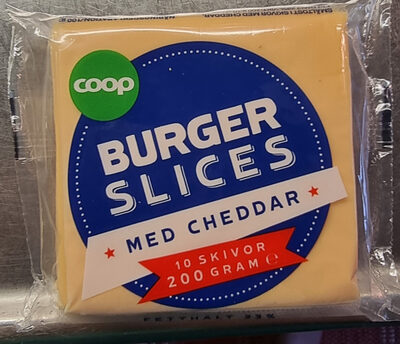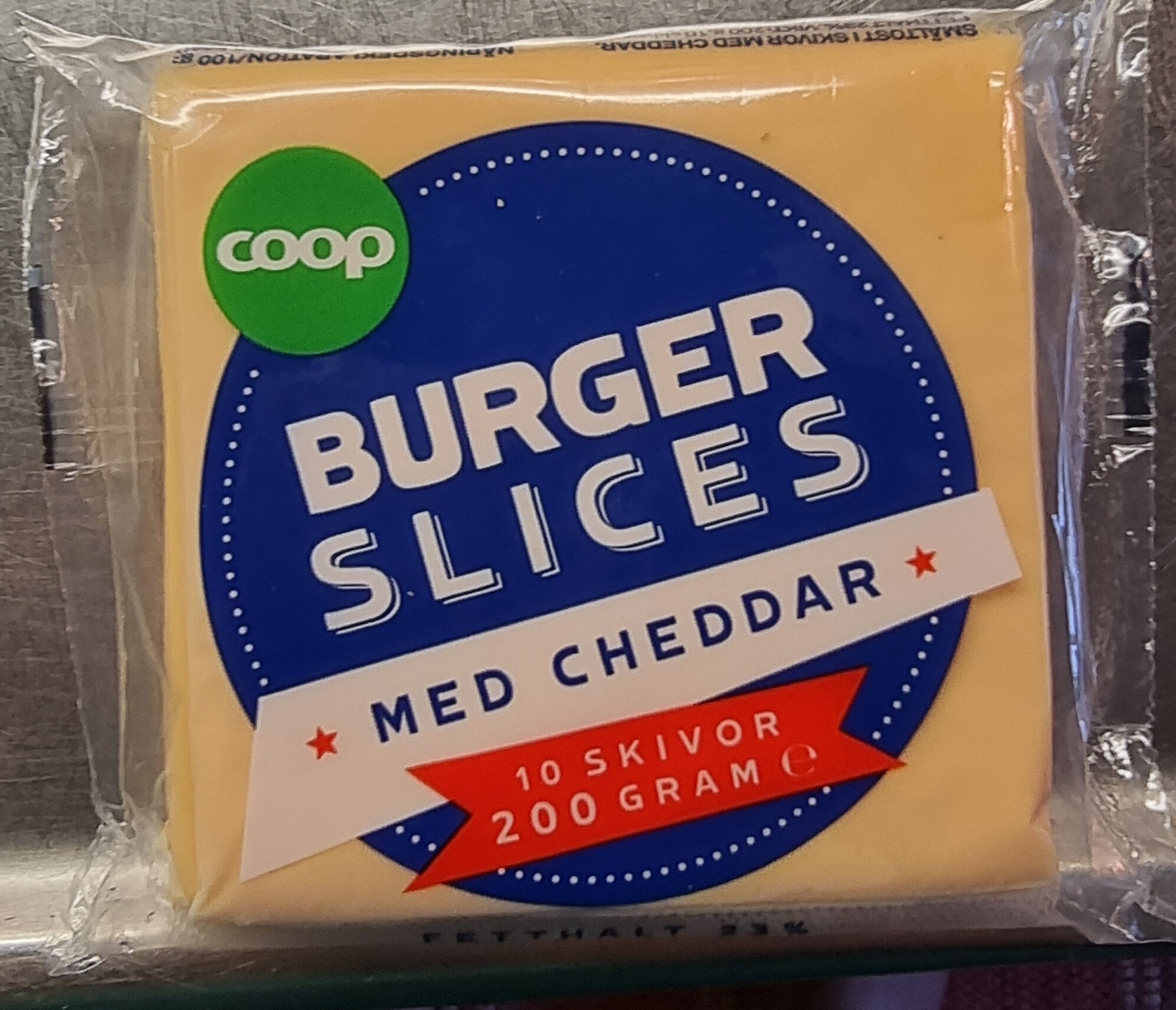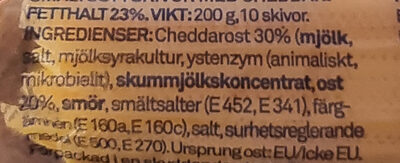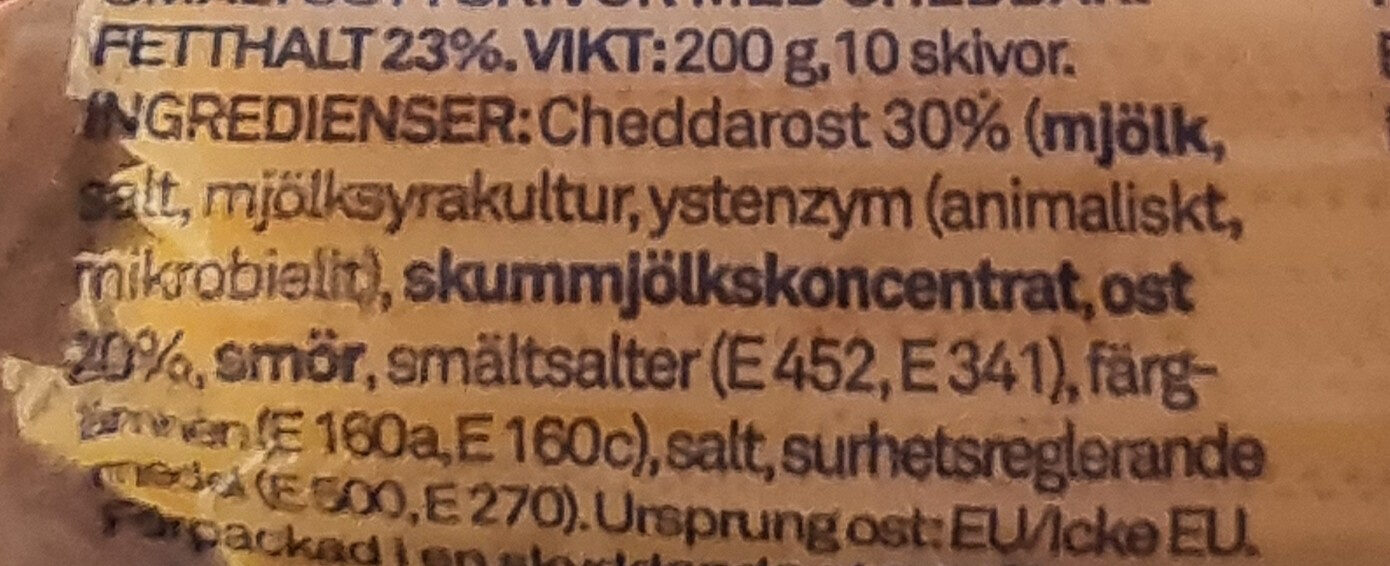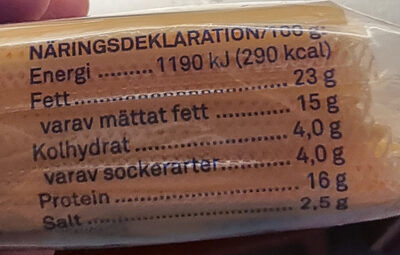Help us make food transparency the norm!
As a non-profit organization, we depend on your donations to continue informing consumers around the world about what they eat.
The food revolution starts with you!
Burger slices med cheddar - Coop - 200 g
Burger slices med cheddar - Coop - 200 g
Streckkod: 7300156588494 (EAN / EAN-13)
Kvantitet: 200 g
Varumärken: Coop
Kategorier: Mejeriprodukt, Fermenterad mat, Fermenterade mjölkprodukter, Ostar, en:Processed cheese, en:Processed cheese in slices
Etiketter, certifieringar, utmärkelser: Icke EU-jordbruk
Origin of the product and/or its ingredients: Ursprung ost: EU, Icke EU.
Ingredients ursprung: en:European Union and Non European Union
Tillverknings eller bearbetningsplats: Österrike, Hörbranz
Spårbarhetskod: AT 80253 EC
Butiker: Coop
Länder där såld: Sverige
Matching with your preferences
Hälsa
Ingredienser
-
19 ingredienser
Cheddarost 30% (mjölk, salt, mjölksyrakultur, ystenzym (animaliskt, mikrobiellt), skummjölkskoncentrat, ost 20%, smör, smältsalter (E452,E341), färgämne 160a,E160c),salt,surhetsreglerande medel (E500,E270).Allergener: Mjölk
Food processing
-
Ultra processed foods
Elements that indicate the product is in the 4 - Ultra bearbetade livsmedel och drycker group:
- Tillsats: E160c - Paprikaoleoresin
- Tillsats: E452 - Polyfosfater
Food products are classified into 4 groups according to their degree of processing:
- Obearbetade eller minimalt bearbetade livsmedel
- Bearbetade kulinariska ingredienser
- Halvfabrikat
- Ultra processed foods
The determination of the group is based on the category of the product and on the ingredients it contains.
Tillsatser
-
E270 - Mjölksyra
Lactic acid: Lactic acid is an organic compound with the formula CH3CH-OH-COOH. In its solid state, it is white and water-soluble. In its liquid state, it is colorless. It is produced both naturally and synthetically. With a hydroxyl group adjacent to the carboxyl group, lactic acid is classified as an alpha-hydroxy acid -AHA-. In the form of its conjugate base called lactate, it plays a role in several biochemical processes. In solution, it can ionize a proton from the carboxyl group, producing the lactate ion CH3CH-OH-CO−2. Compared to acetic acid, its pKa is 1 unit less, meaning lactic acid deprotonates ten times more easily than acetic acid does. This higher acidity is the consequence of the intramolecular hydrogen bonding between the α-hydroxyl and the carboxylate group. Lactic acid is chiral, consisting of two optical isomers. One is known as L--+--lactic acid or -S--lactic acid and the other, its mirror image, is D--−--lactic acid or -R--lactic acid. A mixture of the two in equal amounts is called DL-lactic acid, or racemic lactic acid. Lactic acid is hygroscopic. DL-lactic acid is miscible with water and with ethanol above its melting point which is around 17 or 18 °C. D-lactic acid and L-lactic acid have a higher melting point. In animals, L-lactate is constantly produced from pyruvate via the enzyme lactate dehydrogenase -LDH- in a process of fermentation during normal metabolism and exercise. It does not increase in concentration until the rate of lactate production exceeds the rate of lactate removal, which is governed by a number of factors, including monocarboxylate transporters, concentration and isoform of LDH, and oxidative capacity of tissues. The concentration of blood lactate is usually 1–2 mM at rest, but can rise to over 20 mM during intense exertion and as high as 25 mM afterward. In addition to other biological roles, L-lactic acid is the primary endogenous agonist of hydroxycarboxylic acid receptor 1 -HCA1-, which is a Gi/o-coupled G protein-coupled receptor -GPCR-.In industry, lactic acid fermentation is performed by lactic acid bacteria, which convert simple carbohydrates such as glucose, sucrose, or galactose to lactic acid. These bacteria can also grow in the mouth; the acid they produce is responsible for the tooth decay known as caries. In medicine, lactate is one of the main components of lactated Ringer's solution and Hartmann's solution. These intravenous fluids consist of sodium and potassium cations along with lactate and chloride anions in solution with distilled water, generally in concentrations isotonic with human blood. It is most commonly used for fluid resuscitation after blood loss due to trauma, surgery, or burns.Källa: Wikipedia (Engelska)
-
E341 - Kalciumfosfater
Calcium phosphate: Calcium phosphate is a family of materials and minerals containing calcium ions -Ca2+- together with inorganic phosphate anions. Some so-called calcium phosphates contain oxide and hydroxide as well. They are white solids of nutritious value.Källa: Wikipedia (Engelska)
-
E500 - Natriumkarbonater
Sodium carbonate: Sodium carbonate, Na2CO3, -also known as washing soda, soda ash and soda crystals, and in the monohydrate form as crystal carbonate- is the water-soluble sodium salt of carbonic acid. It most commonly occurs as a crystalline decahydrate, which readily effloresces to form a white powder, the monohydrate. Pure sodium carbonate is a white, odorless powder that is hygroscopic -absorbs moisture from the air-. It has a strongly alkaline taste, and forms a moderately basic solution in water. Sodium carbonate is well known domestically for its everyday use as a water softener. Historically it was extracted from the ashes of plants growing in sodium-rich soils, such as vegetation from the Middle East, kelp from Scotland and seaweed from Spain. Because the ashes of these sodium-rich plants were noticeably different from ashes of timber -used to create potash-, they became known as "soda ash". It is synthetically produced in large quantities from salt -sodium chloride- and limestone by a method known as the Solvay process. The manufacture of glass is one of the most important uses of sodium carbonate. Sodium carbonate acts as a flux for silica, lowering the melting point of the mixture to something achievable without special materials. This "soda glass" is mildly water-soluble, so some calcium carbonate is added to the melt mixture to make the glass produced insoluble. This type of glass is known as soda lime glass: "soda" for the sodium carbonate and "lime" for the calcium carbonate. Soda lime glass has been the most common form of glass for centuries. Sodium carbonate is also used as a relatively strong base in various settings. For example, it is used as a pH regulator to maintain stable alkaline conditions necessary for the action of the majority of photographic film developing agents. It acts as an alkali because when dissolved in water, it dissociates into the weak acid: carbonic acid and the strong alkali: sodium hydroxide. This gives sodium carbonate in solution the ability to attack metals such as aluminium with the release of hydrogen gas.It is a common additive in swimming pools used to raise the pH which can be lowered by chlorine tablets and other additives which contain acids. In cooking, it is sometimes used in place of sodium hydroxide for lyeing, especially with German pretzels and lye rolls. These dishes are treated with a solution of an alkaline substance to change the pH of the surface of the food and improve browning. In taxidermy, sodium carbonate added to boiling water will remove flesh from the bones of animal carcasses for trophy mounting or educational display. In chemistry, it is often used as an electrolyte. Electrolytes are usually salt-based, and sodium carbonate acts as a very good conductor in the process of electrolysis. In addition, unlike chloride ions, which form chlorine gas, carbonate ions are not corrosive to the anodes. It is also used as a primary standard for acid-base titrations because it is solid and air-stable, making it easy to weigh accurately.Källa: Wikipedia (Engelska)
Ingrediensanalys
-
Palmolja innehåll okänt
Okända ingredienser: Animaliskt, Skummjölkskoncentrat, Färgämne-160aVissa ingredienser kunde inte kännas igen.
Vi behöver din hjälp!
You can help us recognize more ingredients and better analyze the list of ingredients for this product and others:
- Edit this product page to correct spelling mistakes in the ingredients list, and/or to remove ingredients in other languages and sentences that are not related to the ingredients.
- Add new entries, synonyms or translations to our multilingual lists of ingredients, ingredient processing methods, and labels.
If you would like to help, join the #ingredients channel on our Slack discussion space and/or learn about ingredients analysis on our wiki. Thank you!
-
Icke-vegan
Non-vegan ingredients: Cheddar, Mjölk, Ost, SmörVissa ingredienser kunde inte kännas igen.
Vi behöver din hjälp!
You can help us recognize more ingredients and better analyze the list of ingredients for this product and others:
- Edit this product page to correct spelling mistakes in the ingredients list, and/or to remove ingredients in other languages and sentences that are not related to the ingredients.
- Add new entries, synonyms or translations to our multilingual lists of ingredients, ingredient processing methods, and labels.
If you would like to help, join the #ingredients channel on our Slack discussion space and/or learn about ingredients analysis on our wiki. Thank you!
-
Vegetarisk status okänd
Okända ingredienser: Animaliskt, Skummjölkskoncentrat, Färgämne-160aVissa ingredienser kunde inte kännas igen.
Vi behöver din hjälp!
You can help us recognize more ingredients and better analyze the list of ingredients for this product and others:
- Edit this product page to correct spelling mistakes in the ingredients list, and/or to remove ingredients in other languages and sentences that are not related to the ingredients.
- Add new entries, synonyms or translations to our multilingual lists of ingredients, ingredient processing methods, and labels.
If you would like to help, join the #ingredients channel on our Slack discussion space and/or learn about ingredients analysis on our wiki. Thank you!
-
Details of the analysis of the ingredients
Vi behöver din hjälp!
Vissa ingredienser kunde inte kännas igen.
Vi behöver din hjälp!
You can help us recognize more ingredients and better analyze the list of ingredients for this product and others:
- Edit this product page to correct spelling mistakes in the ingredients list, and/or to remove ingredients in other languages and sentences that are not related to the ingredients.
- Add new entries, synonyms or translations to our multilingual lists of ingredients, ingredient processing methods, and labels.
If you would like to help, join the #ingredients channel on our Slack discussion space and/or learn about ingredients analysis on our wiki. Thank you!
: Cheddarost 30% (mjölk, salt, mjölksyrakultur, ystenzym (animaliskt, mikrobiellt), skummjölkskoncentrat, ost 20%, smör, smältsalter (e452, e341), färgämne 160a, e160c), salt, surhetsreglerande medel (e500, e270)- Cheddarost -> en:cheddar - vegan: no - vegetarian: maybe - ciqual_food_code: 12726 - percent: 30
- mjölk -> en:milk - vegan: no - vegetarian: yes - ciqual_proxy_food_code: 19051
- salt -> en:salt - vegan: yes - vegetarian: yes - ciqual_food_code: 11058
- mjölksyrakultur -> en:lactic-ferments - vegan: maybe - vegetarian: yes
- ystenzym -> en:microbial-rennet - vegan: yes - vegetarian: yes
- animaliskt -> sv:animaliskt
- mikrobiellt -> en:microbial-rennet - vegan: yes - vegetarian: yes
- skummjölkskoncentrat -> sv:skummjölkskoncentrat
- ost -> en:cheese - vegan: no - vegetarian: maybe - ciqual_proxy_food_code: 12999 - percent: 20
- smör -> en:butter - vegan: no - vegetarian: yes - ciqual_proxy_food_code: 16400
- smältsalter -> en:emulsifying-salts
- e452 -> en:e452 - vegan: yes - vegetarian: yes
- e341 -> en:e341 - vegan: yes - vegetarian: yes
- färgämne 160a -> sv:färgämne-160a
- e160c -> en:e160c - vegan: yes - vegetarian: yes
- salt -> en:salt - vegan: yes - vegetarian: yes - ciqual_food_code: 11058
- surhetsreglerande medel -> en:acidity-regulator
- e500 -> en:e500 - vegan: yes - vegetarian: yes
- e270 -> en:e270 - vegan: yes - vegetarian: yes
- Ursprung ost: EU,
Ursprung ost -> sv:ursprung-ost
Näring
-
Poor nutritional quality
⚠ ️Warning: the amount of fruits, vegetables and nuts is not specified on the label, it was estimated from the list of ingredients: 0This product is not considered a beverage for the calculation of the Nutri-Score.
Positiva poäng: 5
- Proteiner: 5 / 5 (värde: 16, avrundat värde: 16)
- Fiber: 0 / 5 (värde: 0, avrundat värde: 0)
- Frukt, grönsaker, nötter och raps- / valnöt- / olivoljor: 0 / 5 (värde: 0, avrundat värde: 0)
Negativa poäng: 23
- Energi: 3 / 10 (värde: 1190, avrundat värde: 1190)
- Socker: 0 / 10 (värde: 4, avrundat värde: 4)
- Mättat fett: 10 / 10 (värde: 15, avrundat värde: 15)
- Natrium: 10 / 10 (värde: 1000, avrundat värde: 1000)
The points for proteins are counted because the product is in the cheeses category.
Näringsvärde: (23 - 5)
Nutri-Score:
-
Näringsvärden
-
Fett i hög kvantitet (23%)
What you need to know- A high consumption of fat, especially saturated fats, can raise cholesterol, which increases the risk of heart diseases.
Recommendation: Limit the consumption of fat and saturated fat- Choose products with lower fat and saturated fat content.
-
Mättat fett i hög kvantitet (15%)
What you need to know- A high consumption of fat, especially saturated fats, can raise cholesterol, which increases the risk of heart diseases.
Recommendation: Limit the consumption of fat and saturated fat- Choose products with lower fat and saturated fat content.
-
Sockerarter i låg kvantitet (4%)
What you need to know- A high consumption of sugar can cause weight gain and tooth decay. It also augments the risk of type 2 diabetes and cardio-vascular diseases.
Recommendation: Limit the consumption of sugar and sugary drinks- Sugary drinks (such as sodas, fruit beverages, and fruit juices and nectars) should be limited as much as possible (no more than 1 glass a day).
- Choose products with lower sugar content and reduce the consumption of products with added sugars.
-
Salt i hög kvantitet (2.5%)
What you need to know- A high consumption of salt (or sodium) can cause raised blood pressure, which can increase the risk of heart disease and stroke.
- Many people who have high blood pressure do not know it, as there are often no symptoms.
- Most people consume too much salt (on average 9 to 12 grams per day), around twice the recommended maximum level of intake.
Recommendation: Limit the consumption of salt and salted food- Reduce the quantity of salt used when cooking, and don't salt again at the table.
- Limit the consumption of salty snacks and choose products with lower salt content.
-
-
Näringsfakta
Näringsfakta Som såld
för 100 g / 100 mlCompared to: Ostar Energi 1 190 kj
(290 kcal)+7 % Fett 23 g +12 % Mättat fett 15 g +14 % Kolhydrat 4 g +121 % Sockerarter 4 g +215 % Fiber - Protein 16 g −6 % Salt 2,5 g +77 % Fruits‚ vegetables‚ nuts and rapeseed‚ walnut and olive oils (estimate from ingredients list analysis) 0 %
Miljö
-
Eco-Score D - Hög miljöpåverkan
The Eco-Score is an experimental score that summarizes the environmental impacts of food products.→ The Eco-Score was initially developped for France and it is being extended to other European countries. The Eco-Score formula is subject to change as it is regularly improved to make it more precise and better suited to each country.Life cycle analysis
-
Average impact of products of the same category: C (Score: 54/100)
Kategori: Processed cheese, in slices
Kategori: Processed cheese, in slices
- PEF environmental score: 0.49 (the lower the score, the lower the impact)
- including impact on climate change: 5.22 kg CO2 eq/kg of product
Stage Impact Jordbruk
84.4 %Bearbetar
5.6 %Förpackning
4.4 %Transportation
3.3 %Distribution
1.8 %Consumption
0.5 %
Bonuses and maluses
-
Origins of ingredients with a high impact
Malus: -5
Environmental policy: -5
Transportation: 0
Origin of the product and/or its ingredients % of ingredients Impact European Union and Non European Union 100 %Hög
-
Packaging with a high impact
Malus: -15
Form Material Återvinning Impact 1 Förpackningsmaterial 07 OTHER Recycle with plastics Hög 10 Wrapper 07 OTHER Recycle with plastics Hög ⚠ ️ The information about the packaging of this product is not sufficiently precise (exact shapes and materials of all components of the packaging).⚠ ️ For a more precise calculation of the Eco-Score, you can modify the product page and add them.
If you are the manufacturer of this product, you can send us the information with our free platform for producers.
Eco-Score for this product
-
Impact for this product: D (Score: 34/100)
Produkt: Burger slices med cheddar - Coop - 200 g
Life cycle analysis score: 54
Sum of bonuses and maluses: -20
Final score: 34/100
-
Carbon footprint
-
Equal to driving 2.7 km in a petrol car
522 g CO² per 100g of product
The carbon emission figure comes from ADEME's Agribalyse database, for the category: Processed cheese, in slices (Source: ADEME Agribalyse Database)
Stage Impact Jordbruk
85.1 %Bearbetar
5.0 %Förpackning
5.0 %Transportation
4.0 %Distribution
0.7 %Consumption
0.1 %
Förpackning
-
Packaging with a high impact
-
Packaging parts
1 x Förpackningsmaterial (07 OTHER)
10 x Wrapper (07 OTHER)
-
Packaging materials
Material % Packaging weight Packaging weight per 100 g of product Plast
-
Transportation
-
Origins of ingredients
Origins of ingredients with a high impact
Origin of the product and/or its ingredients % of ingredients Impact European Union and Non European Union 100 %Hög
Report a problem
-
Incomplete or incorrect information?
Category, labels, ingredients, allergens, nutritional information, photos etc.
If the information does not match the information on the packaging, please complete or correct it. Open Food Facts is a collaborative database, and every contribution is useful for all.
Datakällor
Produkt tillagd den av fringillus
Senast ändrad produktsida på av beardedtechfoodguy.
Produktsida också redigerad av akitainu, inf, openfoodfacts-contributors, packbot.
